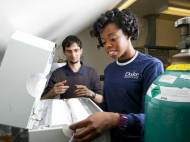Improving hydrogen production with a bit of rust
 While hydrogen can be found nearly everywhere in the environment and it can be used to produce power, producing and collecting molecular hydrogen with current methods isn’t competitive with other sources of energy. Duke University engineers have developed a novel method for producing clean hydrogen, which could prove essential to weaning society off of fossil fuels and their environmental implications.
While hydrogen can be found nearly everywhere in the environment and it can be used to produce power, producing and collecting molecular hydrogen with current methods isn’t competitive with other sources of energy. Duke University engineers have developed a novel method for producing clean hydrogen, which could prove essential to weaning society off of fossil fuels and their environmental implications.
Unlike other currently available methods which have carbon monoxide as a byproduct of hydrogen production, the new catalytic approach devised by Duke engineers reduces carbon monoxide levels to nearly zero in the presence of hydrogen and the harmless byproducts of carbon dioxide and water. They also demonstrated that they could produce hydrogen by reforming fuel at much lower temperatures than conventional methods, thus making the process more practical.
The method allows consistent production of hydrogen with less than 0.002 percent (20 parts per million) of carbon monoxide The Duke researchers achieved these levels by switching the recipe for the nanoparticles used as catalysts for the reactions to oxidize carbon monoxide in hydrogen-rich gases.
Traditional methods of cleaning hydrogen, which are not nearly as efficient as this new approach, also involve gold-iron oxide nanoparticles as the catalyst, while the Duke researchers made both the iron oxide (rust) and the gold the focus of the catalytic process.
“It had been assumed that the iron oxide nanoparticles were only ‘scaffolds’ holding the gold nanoparticles together, and that the gold was responsible for the chemical reactions”, said Titilayo “Titi” Shodiya, a Duke graduate student and first author of the research paper. “However, we found that increasing the surface area of the iron oxide dramatically increased the catalytic activity of the gold.”
One of the newest approaches to producing renewable energy is the use of biomass-derived alcohol-based sources, such as methanol. When methanol is treated with steam, or reformed, it creates a hydrogen-rich mixture that can be used in fuel cells. Fuel cells produce electricity through chemical reactions, most commonly involving hydrogen. Also, many industrial processes require hydrogen as a chemical reagent and there are efforts to create commercially available vehicles which run on hydrogen as a primary fuel source.
“The main problem with this approach is that it also produces carbon monoxide, which is not only toxic to life, but also quickly damages the catalyst on fuel cell membranes that are crucial to the functioning of a fuel cell”, said Nico Hotz, assistant professor of mechanical engineering and materials science at Duke’s Pratt School of Engineering. “It doesn’t take much carbon monoxide to ruin these membranes.”
Duke researchers ran the reaction for more than 200 hours and found no reduction in the ability of the catalyst to reduce the amount of carbon monoxide in the hydrogen gas.
“The mechanism for this is not exactly understood yet. However, while current thinking is that the size of the gold particles is key, we believe the emphasis of further research should focus on iron oxide’s role in the process”, said Shodiya.
For more information, read the paper published in the Journal of Catalysis: “Novel nano-scale Au/α-Fe2O3 catalyst for the preferential oxidation of CO in biofuel reformate gas”.









Leave your response!